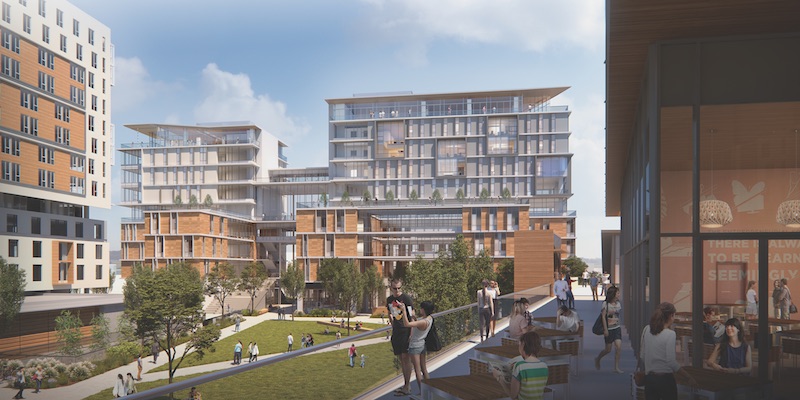Project teams are finding innovative ways to implement smart building technology. New partnerships are one avenue, says Matthew Toner, CBRE’s Managing Director of Smart Buildings and IoT, describing CBRE’s acquisition of Johnson Controls’ Global Workplace Solutions unit. “We’re innovating in proprietary solutions when a client needs a certain product that is not available on the market,” he says.
Edge Technologies has entered into alliances with the International WELL Building Institute and wellness-focused real estate developer Delos. These collaborations, says Executive Managing Director Jan-Hein Lakeman, will help analyze data from its latest smart projects in new ways while giving those organizations access to important post-occupancy information at scale. Edge has identified 13 U.S. cities as targets for new development.
The first of those, designed in collaboration with Perkins+Will, repositions a suburban New Jersey office park into a “connected campus” and headquarters for consumer goods maker Unilever. The building’s 15,000 installed sensors measure temperature, illumination, carbon dioxide, and humidity—a suite of smart tech solutions credited with cutting energy bills by 50% since startup in 2018.
In Denver, WSP’s new innovation center employs digital twin modeling programs to monitor building performance live in the virtual world. The eventual goal: Adjustments made in the VR model will push back into the actual operational model. “This is a great benefit,” notes WSP SVP Herbert Els. “We are looking at continual commissioning and engagement with clients, long after occupancy.”
This idea of “living labs” has also taken hold at HKS Architects, where Tommy Zakrzewski, PhD, Director of Integrative Energy Engineering, uses similar digital twin-modeling concepts to understand how well the firm’s new Chicago office operates, a tool that HKS can apply to client projects.
“Tied to a LEED energy-compliance model, we’ve been able to monitor trends and correct building or workspace performance through a front-end dashboard,” says Zakrzewski. “This kind of system is key for observing positive and negative facility performance and exploring new ideas.”
Working with Clark Construction and Safdie Rabines Architects, HKS is employing these ideas to create a new connected community at the University of California, San Diego’s new North Torrey Pines Living and Learning Neighborhood (see HKS rendering above). A 10-acre interdisciplinary environment blending academic, residential, commercial, and cultural programming, the project seeks to optimize the performance of six different buildings, showcasing “how architecture, engineering, and sustainability come together in a holistic way,” says Zakrzewski.
Related Stories
Sponsored | Resiliency | Dec 14, 2022
Flood protection: What building owners need to know to protect their properties
This course from Walter P Moore examines numerous flood protection approaches and building owner needs before delving into the flood protection process. Determining the flood resilience of a property can provide a good understanding of risk associated costs.
Mass Timber | Dec 1, 2022
Cross laminated timber market forecast to more than triple by end of decade
Cross laminated timber (CLT) is gaining acceptance as an eco-friendly building material, a trend that will propel its growth through the end of the 2020s. The CLT market is projected to more than triple from $1.11 billion in 2021 to $3.72 billion by 2030, according to a report from Polaris Market Research.
K-12 Schools | Nov 30, 2022
School districts are prioritizing federal funds for air filtration, HVAC upgrades
U.S. school districts are widely planning to use funds from last year’s American Rescue Plan (ARP) to upgrade or improve air filtration and heating/cooling systems, according to a report from the Center for Green Schools at the U.S. Green Building Council. The report, “School Facilities Funding in the Pandemic,” says air filtration and HVAC upgrades are the top facility improvement choice for the 5,004 school districts included in the analysis.
Wood | Nov 16, 2022
5 steps to using mass timber in multifamily housing
A design-assist approach can provide the most effective delivery method for multifamily housing projects using mass timber as the primary building element.
Giants 400 | Nov 14, 2022
4 emerging trends from BD+C's 2022 Giants 400 Report
Regenerative design, cognitive health, and jobsite robotics highlight the top trends from the 519 design and construction firms that participated in BD+C's 2022 Giants 400 Report.
Contractors | Nov 14, 2022
U.S. construction firms lean on technology to manage growth and weather the pandemic
In 2021, Gilbane Building Company and Nextera Robotics partnered in a joint venture to develop an artificial intelligence platform utilizing a fleet of autonomous mobile robots. The platform, dubbed Didge, is designed to automate construction management, maximize reliability and safety, and minimize operational costs. This was just one of myriad examples over the past 18 months of contractor giants turning to construction technology (ConTech) to gather jobsite data, manage workers and equipment, and smooth the construction process.
University Buildings | Nov 13, 2022
University of Washington opens mass timber business school building
Founders Hall at the University of Washington Foster School of Business, the first mass timber building at Seattle campus of Univ. of Washington, was recently completed. The 84,800-sf building creates a new hub for community, entrepreneurship, and innovation, according the project’s design architect LMN Architects.
Sponsored | Steel Buildings | Nov 7, 2022
Steel structures offer faster path to climate benefits
Faster delivery of buildings isn’t always associated with sustainability benefits or long-term value, but things are changing. An instructive case is in the development of steel structures that not only allow speedier erection times, but also can reduce embodied carbon and create durable, highly resilient building approaches.
Mass Timber | Aug 30, 2022
Mass timber construction in 2022: From fringe to mainstream
Two Timberlab executives discuss the market for mass timber construction and their company's marketing and manufacturing strategies. Sam Dicke, Business Development Manager, and Erica Spiritos, Director of Preconstruction, Timberlab, speak with BD+C's John Caulfield.
Sponsored | BD+C University Course | Aug 24, 2022
Solutions for cladding performance and supply issues
This course covers design considerations and cladding assembly choices for creating high-performance building envelopes — a crucial element in healthy, energy-efficient buildings.
















